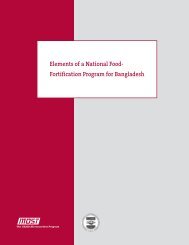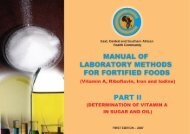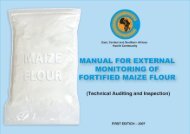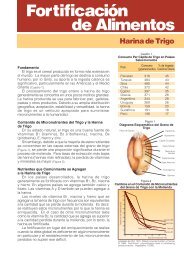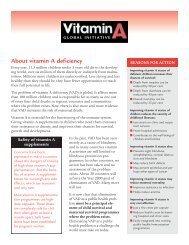manual of methods for determining micronutrients in fortified foods
manual of methods for determining micronutrients in fortified foods
manual of methods for determining micronutrients in fortified foods
Create successful ePaper yourself
Turn your PDF publications into a flip-book with our unique Google optimized e-Paper software.
− Volumetric flasks (100 and 10 mL)<br />
− Nitrogen blanket apparatus 8<br />
V. Reagents<br />
−<br />
−<br />
−<br />
−<br />
−<br />
−<br />
−<br />
−<br />
−<br />
−<br />
Certified vitam<strong>in</strong> A acetate concentrate (USP) or<br />
Ret<strong>in</strong>yl palmitate, all-trans.<br />
Acetic acid glacial, AR<br />
Acetonitrile, AR<br />
Isopropanol, AR<br />
Methanol, HPLC grade<br />
Absolute ethanol AR<br />
Tetrahydr<strong>of</strong>uran (THF), AR grade<br />
Hexane (n-Hexane 95% <strong>for</strong> HPLC)<br />
Pyrogallic acid, crystal, AR grade<br />
VI. Solutions<br />
a. Mobile phase: Comb<strong>in</strong>e 890 mL methanol and 110 mL distilled water. Mix well. Stir<br />
overnight to degas or prior to use.<br />
b. THF-methanol [50+50]: Comb<strong>in</strong>e 500 mL tetrahydr<strong>of</strong>uran and 500 mL 95% ethanol. Mix well.<br />
c. Potassium hydroxide solution-50%: Slowly add 500 g <strong>of</strong> KOH pellets to 500 mL water<br />
conta<strong>in</strong>ed <strong>in</strong> a 2L thick walled Erlenmeyer flask. The solution gives <strong>of</strong>f substantial heat while<br />
KOH is dissolv<strong>in</strong>g. Add the KOH <strong>in</strong> 100 g portions while the flask is be<strong>in</strong>g cooled with cold water.<br />
Swirl the flask gently to aid <strong>in</strong> dissolution <strong>of</strong> the KOH. Store <strong>in</strong> glass conta<strong>in</strong>er with cork stopper.<br />
d. Wash<strong>in</strong>g solution-acetonitrile-20% <strong>in</strong> water: Comb<strong>in</strong>e 80 mL water and 20 mLacetonitrile.<br />
Mix well.<br />
e. Vitam<strong>in</strong> A work<strong>in</strong>g standard (ca 5 µg ret<strong>in</strong>ol/mL)<br />
1. Us<strong>in</strong>g USP standard: Weigh 50 mg ret<strong>in</strong>yl acetate concentrate <strong>in</strong>to a 100-mL volumetric<br />
flask. Record weight to nearest 0.1 mg. Record concentration <strong>in</strong> mg/g per USP certification.<br />
Add a small amount <strong>of</strong> acetone (less than 3 mL) to aid dissolution. Dilute to volume with<br />
absolute ethanol. Store at 4°C <strong>in</strong> dark. Solution is stable <strong>for</strong> two weeks.<br />
2. Us<strong>in</strong>g ret<strong>in</strong>yl palmitate:<br />
Stock solution: Weigh 55 mg ret<strong>in</strong>yl palmitate <strong>in</strong>to 100-mL volumetric flask. Record weight<br />
to nearest 0.1 mg. Record purity per supplier certification or purity test. Add pea-sized piece <strong>of</strong><br />
pyrogallic acid. Dissolve and dilute to volume with hexane.<br />
Work<strong>in</strong>g solution: Pipet 2 mL solution to second 100-mL flask and dilute to volume with<br />
absolute ethanol. Store at 4°C <strong>in</strong> dark. Solution is stable <strong>for</strong> two weeks.<br />
8 A supply <strong>of</strong> nitrogen gas with appropriate tub<strong>in</strong>g and connectors to provide a constant nitrogen atmosphere blanket <strong>in</strong> the reflux apparatus dur<strong>in</strong>g<br />
saponification.<br />
- 27 -





